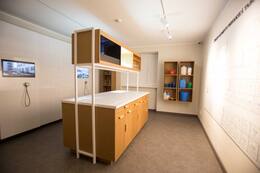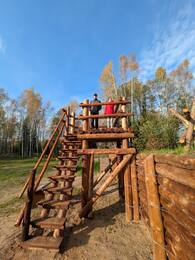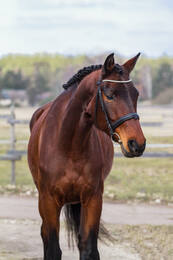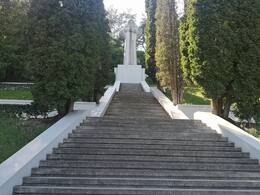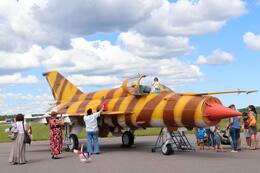Evidence of the World War I and Christmas Battles in Rīga region
Cafe “Dakota” and exposition of military vehicles and equipment
Cafe Dakota is located in Ogre municipality, Ciemupe, on the A6 highway. The exhibit on military heritage allows its owner to combine his hobby and interest in military history with his business of running a cafe. Here you can enjoy a meal and see military equipment, weapons, soldier equipment and aircraft from the end of the 20th century. The exhibit is available to cafe visitors during working hours. Tours are available only in Russian and prior registration is required.
Cultural Heritage Centre "Tīnūži Manor"
The Cultural Heritage Centre ‘Tīnūži Manor’ is located in Ogre municipality, Tīnūži village, 7 km from the cities of Ogre and Ikšķile. The first written evidence about the manor dates back to the 16th century. Until the mid-18th century it was considered an economic production unit with small and insignificant buildings. But over time it grew into a large farm. During World War I, battles between the Russian and German armies took place here, and the Latvian Riflemen were also involved. During the War of Independence Tīnūži manor was used as the headquarters and armoured car park of the 1st Valmiera Infantry Regiment of the Latvian Army. In 1932, the manor was given to the Union of the Latvian War Invalids, which provided accommodation and care for war veterans. During World War II (in 1943) the German Army unit FAT 212 was transferred from Estonia to Tīnūži manor. It was a saboteur unit that prepared soldiers to fight the Red Army. Latvian soldiers were also trained in the arts of intelligence gathering, guerrilla warfare tactics and sabotage. The lord house of Tīnūži manor was destroyed when the Red Army was moving towards Riga. Nowadays it is a place with a beautiful landscape and historical buildings on the banks of the Little Jugla River. Exhibits dedicated to historical events, including the ones concerning the Latvian Riflemen, can be seen at the Cultural Heritage Centre ‘Tīnūži manor’.
Olaine History and Art Museum
The exhibit in the Olaine History and Art Museum is about the period of Soviet occupation in Olaine. A World War I exploration route with restored elements of the fortifications has been created in the territory of the museum. On the site, where the World War I Russian Army defence line once was, a Russian soldier-type dugout has been built and a fragment of a shooting tower can be viewed by visitors. A World War I reinforced concrete fortification can be seen in Jaunolaine, at the intersection to Plakanciems. During World War I, active battles were fought between the Russian and German armies in this area. Latvian Riflemen units were involved in intelligence and various other operations. Marshy lands made it difficult to defend, but this was a very important area in Latvian military history. Olaine was formed due to the convenient location between Jelgava and Riga, where Jaunolaine is currently located. The Olaine manor was nearby. The modern day Olaine was built during the Soviet occupation, when industrial companies began their operations there.
Christmas Battle Museum
The museum is located in “Mangali” house, Valgunde Rural Territory, Jelgava Municipality, and it is a branch of the Latvian War Museum. It was unveiled in 2005 at the site of the Christmas Battles that occurred during World War I. Unique World War I fortifications still remain at the battle sites. The open-air exhibition of the Christmas Battle Museum reconstructs a section of the fortification system – the trench shelter and part of the first line of German defence – the “German rampart”, which is the only object of this kind in the Baltic states.
The Christmas Battles are one of the best known and most dramatic events of World War I in Latvia. They are an event of special importance in Latvian military and cultural history. Intense fighting took place for six days, leading to heavy casualties. The battles are mainly associated with the attack of Latvian Riflemen against the German Army units, which took place in particularly severe and unfavourable winter conditions. This is an unprecedented case of a major combat operation launched without artillery support.
Today, the museum artefacts found at the sites of the battle are on display. The indoor exhibition is open at certain times, while the exhibition of outdoor fortifications is open every day. Tourist routes and nature trails have been created in the surrounding area.
Tīreļi Distillery, horse riding with type of horses used in World War I
Tīreļi Distillery is a small, private farm and strong alcoholic drink brewery near the Christmas Battle Museum and Tīreļi swamp at the Kalnciems bridge over Lielupe. It also offers horseback rides to places significant to World War I. Horseback rides take place on the route Jaunmārupe-Tīreļi and Tīreļi-Jaunbērze. During this ride you'll get the chance to see the surroundings, memorial sites, trenches, Ložmetējkalns and other historical places. Horses are of the same breed that was used during World War I. You can also take a tour of the brewery and see the farm animals. Places for rest, picnics and camping are also available.
Soviet memorial "Mother – Homeland" in Tukums
The World War II Brethren Cemetery Memorial in Tukums is one of the largest Soviet-era memorials in Latvia. It is located in the Hill Cemetery and is visible from the Revolūcijas street. The memorial was unveiled during the Soviet occupation in 1985 to mark the Red Army's victory over Germany. It is dedicated to those who at various times fell in the name of Soviet rule. ‘Mother – Homeland’ was one of the most common images used in the creation of many memorials. The monument was used to communicate communist ideology and propaganda, symbolically strengthening the presence of the occupation regime in Latvia. After the surrender of Germany, the Red Army treated Kurzeme as a territory that had been taken from the enemy and not a liberated part of the USSR. The repressive authorities and the army began the “cleansing of Kurzeme”. Men aged 16-60 were detained, registered and screened. In terms of threat the men of Kurzeme were seen as just as dangerous as the military personnel of the former German Army. This was the start of the Red Army’s crime wave that brought with it murder, rape, theft, arrests and “mysterious disappearances of people”. Only national partisan groups showed armed resistance. The Soviet authorities set up Destruction Battalions (including in Tukums) to eliminate any resistance. The wave of violence and terror culminated in 1949, when deportations took place throughout Latvia.
Aviation Museum “SKY ZOO”
The Aviation Museum “Sky Zoo” is located in Smārde parish, Tukums municipality, in the territory of Jūrmala Airport that was once the Tukums Military Airfield. The exhibit includes aircrafts YAK-40, AN-2, SU22M4, PZL TS-11 Iskra and a helicopter MI-24. Tour of the airfield includes hangars, caponiers and engineering equipment. The airfield was used by both the German and Soviet armies. During the Soviet occupation it was one of the most important military airfields in the territory of Latvia. The fighters stationed there were intended to attack enemy ships and bomb coastal fortifications. On the night of 9 November 1975, a battle alarm was received at the Tukums airfield – there was enemy warship in the territorial waters of the Soviet Union (in the Gulf of Riga), and it had to be destroyed. Several planes took off from Tukums. However, it turned out that it was the Soviet naval warship ‘Storozhevoi’ (Guardian) on which an armed mutiny against the existing Soviet regime took place. When the planes reached the warship, the battle was still ongoing. Later the rebel leader Valery Sablin, a Soviet naval officer, was wounded and the mutiny ended. He was sentenced to death for treason. This was one of the most dramatic events showing the discontent with the regime and marking the approach of its collapse.






